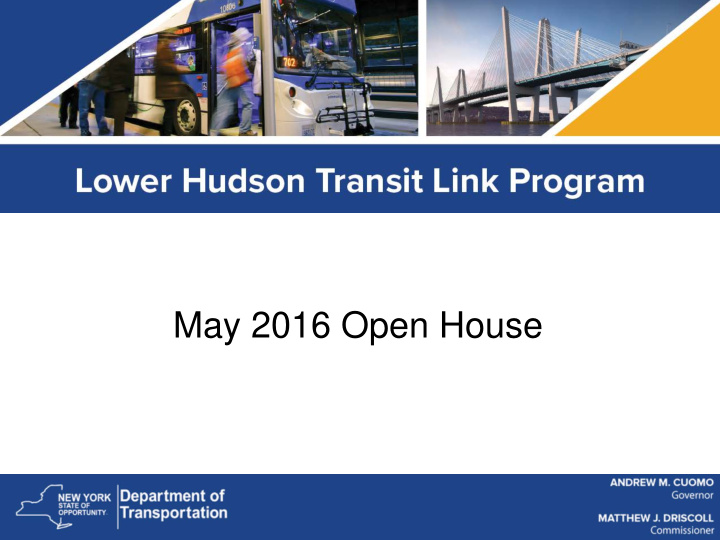



May 2016 Open House
Transportation Needs in the Lower Hudson Valley Over the last half-century, the Lower Hudson Valley region has grown as a popular location for residential and commercial development. So too has the demand for east-west travel between Rockland and Westchester Counties. For more than a decade, state agencies and elected officials studied options for improving transportation options in the region. A comprehensive set of transit proposals were developed to serve travelers along the I-287 corridor, but no project advanced beyond the planning stage for various reasons. Source: LoHud
Mass Transit Task Force Convened In December 2012, at the request of Governor Andrew Cuomo, the New York State Department of Transportation (NYSDOT) and the New York State Thruway Authority (NYSTA) convened the Mass Transit Task Force (MTTF), a 31-member body, and asked them to put forward a transit proposal that could be ready after the opening of the New NY Bridge (NNYB). Co-chaired by the NYSDOT Commissioner and NYSTA Executive Director, the MTTF represented stakeholders – elected officials, transportation experts, advocacy groups – from around the region who were interested in developing transit in the I-287 corridor and their local communities.
Task Force Recommendations The MTTF built upon previous planning efforts to formulate a list of short-, mid-, and long-term transit recommendations for the I-287 corridor that were fiscally viable and had consensus support of local representatives. The focus is on an enhanced rapid bus service for the region. The MTTF recommendations meet the travel needs of residents in the region and maximize the existing transportation infrastructure to accommodate changing demand in a cost-effective manner. Since 2015, NYSDOT, supported by regional transportation stakeholders, has taken the MTTF recommendations and created the Lower Hudson Transit Link (LHTL) program.
Planning for the Lower Hudson Transit Link NYSDOT is sponsoring the Lower Hudson Transit Link (LHTL), a program of technology and transportation strategies to improve travel conditions for all travelers in the I-287 corridor. The LHTL won a $10 million TIGER grant from USDOT in October 2015 and is currently undergoing an Environmental Assessment that is expected to be ready for public review in June 2016.
Planning for the Lower Hudson Transit Link Project goals • Improve reliability and safety • Offer more transit options • Increase access to jobs and housing • Complement investments made in building the NNYB Project elements • New transit service • New bus stations • Pedestrian safety improvements • Integrated Corridor Management (ICM) system
LHLT Bus Routing Plan for 2018 The service to launch in 2018 will connect key residential and employment destinations on both sides of the river.
Potential Future Bus Routing Proposal The MTTF recommended a seven (7) route regional system. The potential for system expansion in the future will be dependent on ridership levels and available funding.
New Transit Vehicle to Announce the New Service The LHTL service includes new transit vehicles, high-quality stations with passenger amenities, an easy-to-understand route structure, more frequent service, and distinctive branding that creates a unique system identity.
High-Quality Bus Shelters Enhance Travel New, well-lit, weather-protected bus shelters allow passengers to stay connected and informed, with technology such as real-time bus arrival information and WiFi. The off- board fare collection will speed up their trip and enhance the travel experience.
Safe and Smart Access New sidewalks, crosswalks, pedestrian signals, and other infrastructure investments will improve access to transit while also making communities more walkable.
Ramp Meters Use Technology to Ease Traffic Ramp metering uses technology to manage congestion on the highway by regulating the flow of vehicles from on-ramps. Ramp meters improve safety and reliability.
Transit Signal Priority (TSP) Lets Buses Move Faster Using TSP, the bus tells the traffic signal to hold the green light so that it may pass through the intersection to pick up and drop off passengers.
Queue Jump Lanes Make Space for Buses Using underutilized right-turn lanes at certain intersections, queue jumps allow buses to move past vehicle queues, increasing transit speed and reliability.
Engaging Local Stakeholders Technical Advisory Committees represent municipalities in both Rockland and Westchester Counties, and a Transit Working Group includes regional agencies. More Open Houses and “pop-up” events to promote the new transit service are planned. 15
Learn More at www.dot.ny.gov/LHTL The LHTL website has newsletters, fact sheets, meeting materials, and other information on the project. Visitors can join the Contact List and leave comments and questions.
Recommend
More recommend